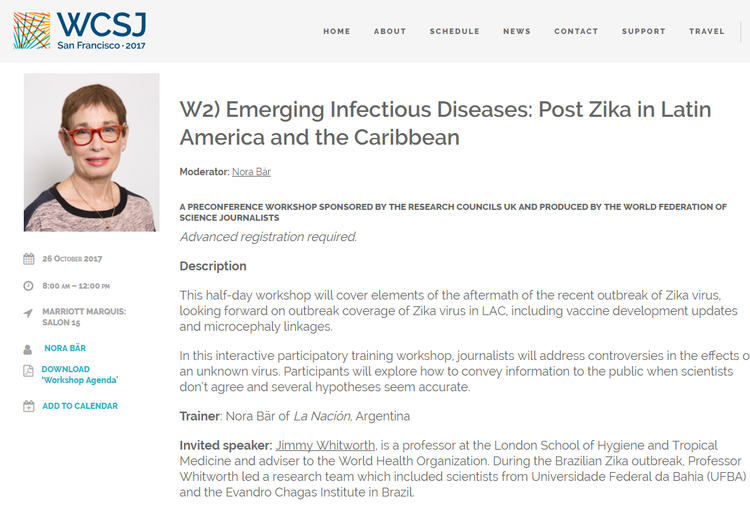
At the recent World Conference of Science Journalists (WCSJ2017) in San Francisco (26-30 October 2017), the WFSJ produced two pre-conference workshops and sponsored by the Research Councils UK on Feeding the World: Achieving Sustainable Agriculture and on Emerging Infectious Diseases: Post Zika in Latin America and the Caribbean.
The participants from Vietnam and Brazil share their experiences in two articles. The article below on Emerging Infectious Diseases workshop was written by the participant from Brazil. Read the Vietnamese’s testimonial on Feeding the World workshop here.
How to report about infectious diseases such as Zika?
I had the opportunity to participate in the workshop “Emerging Infectious Diseases: Post Zika in Latin America and the Caribbean”, during the 10th World Conference of Science Journalists, that took place in San Francisco recently.
In one morning, media professionals from Latin America explored different aspects of the coverage of the Zika outbreak, as well as other infectious diseases. The trainer, Nora Bär, is a columnist on science and health at the Argentinean daily newspaper La Nación and has many years of experience as a science writer.
Professor Jimmy Whitworth, from the London School of Hygiene and Tropical Medicine and adviser to the World Health Organization, was an invited speaker. During the Brazilian Zika outbreak, he led a research team which included Brazilian scientists.
The workshop was very dynamic, with different exercises that prepared the journalists to report on stories with so many uncertainties as is the case with infectious diseases outbreaks.
To start, Nora Bär presented a timeline of events since the outbreak of Zika in Brazil in 2015. The disease is caused by a virus transmitted by Aedes mosquitoes, the same that transmit dengue fever. When Zika was first detected in Brazil, there was a lot of confusion and misinformation, while researchers were trying to understand the new aspects of the infection, such as the link to microcephaly in babies of infected mothers.
The initial state of lack of information can be compared to the situation after the emergence of Aids in the United States in the 1980’s, Nora explained.
Following the outbreak, there was a fast rise in the number of scientific papers on Zika, but some controversies persisted. Some experts and organizations advised women in affected areas not to get pregnant, while others said that this recommendation was naïve.
For a journalist, trying to inform the audience about Zika, it wasn’t easy to get accurate information while the epidemic was unfolding. What is the link between the Zika virus and microcephaly? When will a vaccine be available? Can the disease spread to other regions?
Journalists had to make sense of the information from experts, that often was contradictory, to offer a balanced coverage – adequately interpreting the risk of the situation, without sensationalism and unwarranted alarm, but also not underestimating the risk.
The trainers in the workshop offered an exercise that got the participants thinking about the uncertainties of the case. We were handed a series of statements and had to decide whether these statements were myths or facts. This made us aware of how much we are still confused about Zika.
Professor Whitworth presented data about the Zika virus epidemic in Latin America, providing background information about the virus, the disease, the status of Zika vaccines, and what might happen in the future.
In my opinion, this was a very useful workshop. It was a good idea to bring together a journalist and a researcher, both very knowledgeable trainers who gave clear and concise information about the subject. The insights were useful not only for covering the Zika virus specifically, but any emerging disease because we reflected on what to keep in mind, as journalists, in a time when even experts don’t have the necessary information.
Article by Helen Mendes from Brazil.
November 1, 2017